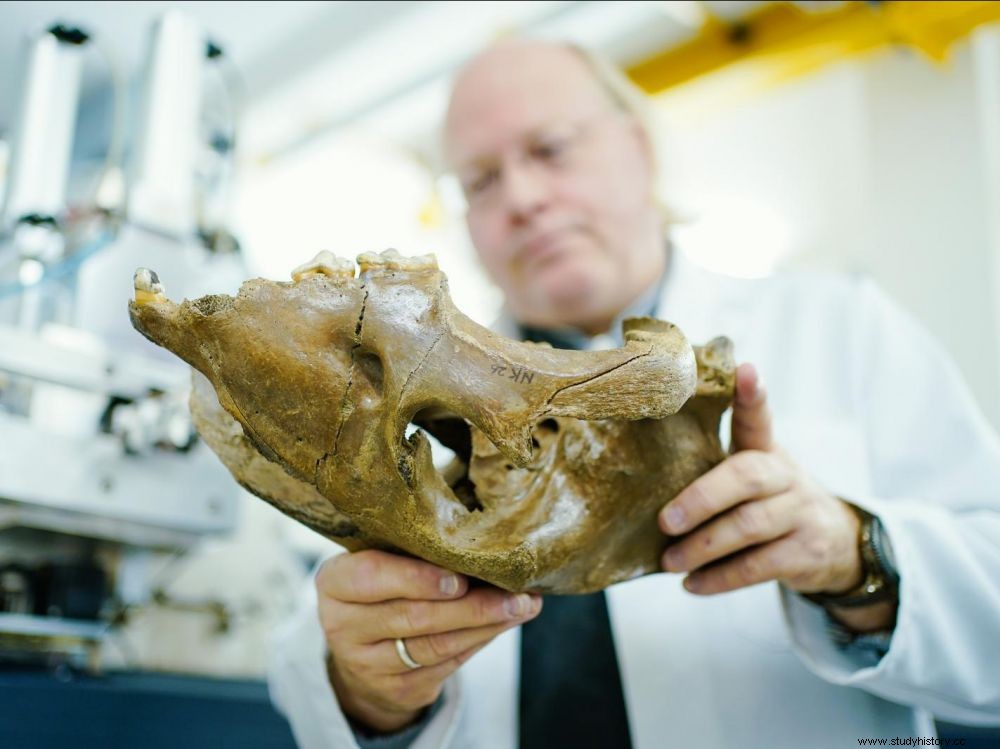Essential in fields such as archeology and geosciences, radiocarbon dating is now more precise thanks to the work of an international team spread over more than seven years. Three new dating curves have been created, each adapted to a specific area of the object studied.

Wilfried Rosendahl, Director of Archeology and World Cultures at the Reiss-Engelhorn Museums, holds the skull of a cave lion in the dating lab at the Curt Engelhorn Center for Archaeometry.
Developed 71 years ago, radiocarbon dating is one of the most well-known techniques for assessing the age of historic objects. From bones to plant remains, any element can be dated absolutely, provided that its age does not exceed 55,000 years.
A question of isotopic ratio
The technique is based on two isotopes of carbon:12C (the stable isotope) and 14C (radioactive). When a plant or animal is alive, it absorbs carbon from its environment. Its isotopic ratio (the ratio between 12C and 14C) is then the same as that of the atmosphere.
When the organism dies, it no longer absorbs new carbon. Over time, the 12C it contains remains stable, but the radioactive 14C decays at an exponential rate:the isotopic ratio therefore changes, and allows the date of death of the organism to be estimated.
This method is all the more complex as the level of 14C in the atmosphere has fluctuated widely throughout history. Calibration curves are then necessary to precisely date the objects studied:these graphs take into account the variation of 14C over time to transform them into absolute age.
New curves based on 15,000 samples
In a press release published this Wednesday, August 12, 2020, a team made up of several universities in the United Kingdom (Sheffield, Belfast, Bristol, Glasgow, Oxford, St Andrews and Historic England) explains that they have made carbon dating more precise thanks to a meta -analysis carried out over seven years.
Developed 71 years ago, radiocarbon dating is one of the most well-known techniques for assessing the age of historic objects. From bones to plant remains, any element can be dated absolutely, provided that its age does not exceed 55,000 years.
A question of isotopic ratio
The technique is based on two isotopes of carbon:12C (the stable isotope) and 14C (radioactive). When a plant or animal is alive, it absorbs carbon from its environment. Its isotopic ratio (the ratio between 12C and 14C) is then the same as that of the atmosphere.
When the organism dies, it no longer absorbs new carbon. Over time, the 12C it contains remains stable, but the radioactive 14C decays at an exponential rate:the isotopic ratio therefore changes, and allows the date of death of the organism to be estimated.
This method is all the more complex as the level of 14C in the atmosphere has fluctuated widely throughout history. Calibration curves are then necessary to precisely date the objects studied:these graphs take into account the variation of 14C over time to transform them into absolute age.
New curves based on 15,000 samples
In a press release published this Wednesday, August 12, 2020, a team made up of several universities in the United Kingdom (Sheffield, Belfast, Bristol, Glasgow, Oxford, St Andrews and Historic England) explains that they have made carbon dating more precise thanks to a meta -analysis carried out over seven years. Unlike previous curves calculated from few objects, the new references are based on measurements from nearly 15,000 samples of objects dating back up to 60,000 years - such as tree rings, stalagmites or even marine sediments.
Combining these measurements has allowed new International Radiocarbon Calibration (IntCal) curves to be drawn, which are essential for accurately dating historical objects.
"By improving the calibration curve, we learn more about our history" , says Paula Reimer, a professor at Queen's University Belfast and project manager for IntCal. "IntCal calibration curves are essential to help answer big questions about the environment and our place in it" , she adds.
Each zone has its calibration curve
Three curves were created during the study, depending on the location of the discovery of the object to be dated:IntCal20 for the northern hemisphere, SHCal20 for the southern hemisphere and Marine20 for the oceans. The 14C content assimilated by the organisms depends on the environmental conditions, which are different in each of these zones. Separating these three environments therefore makes the dating more precise.
"It's a very exciting time to be working in the radiocarbon field" , rejoices Dr. Tim Heaton, lead author of the Marine20 curve. "Advances in this area have really advanced our knowledge. I look forward to seeing what these new recalculated radiocarbon timescales will bring to us in terms of new insights into our past," he concludes.
